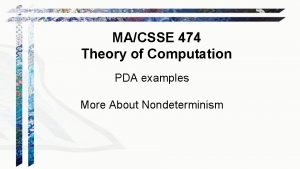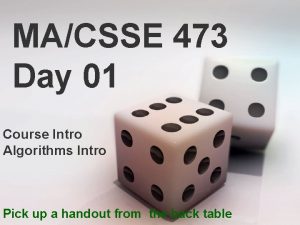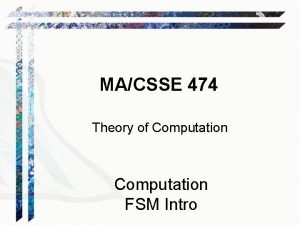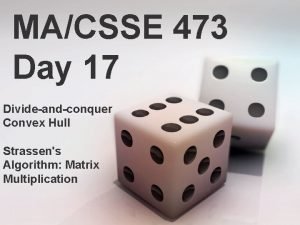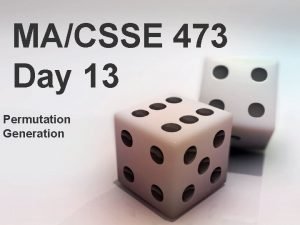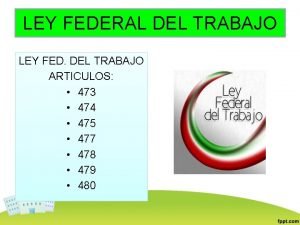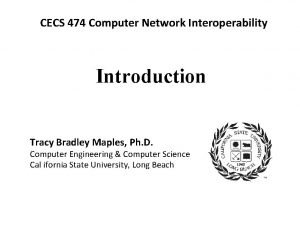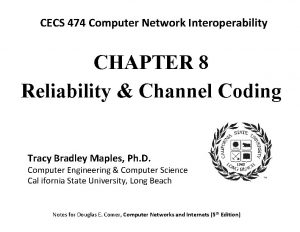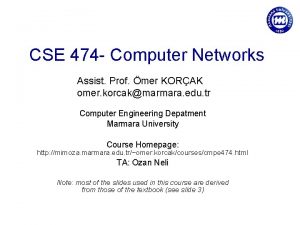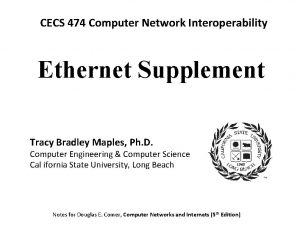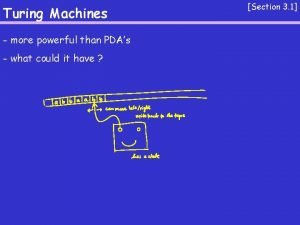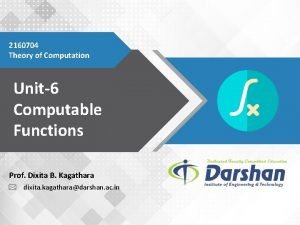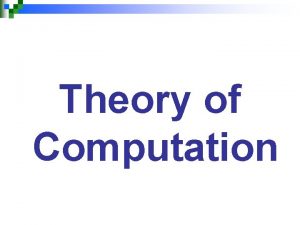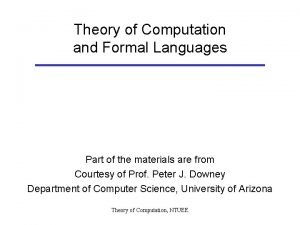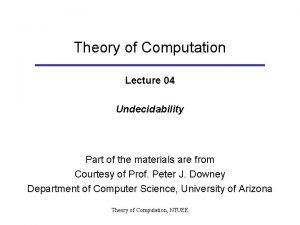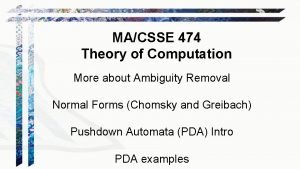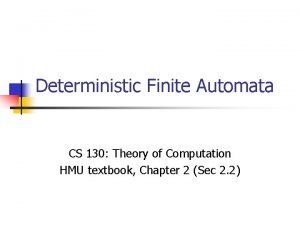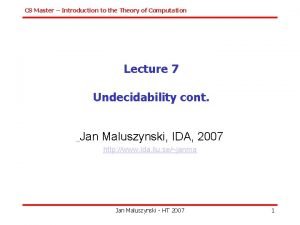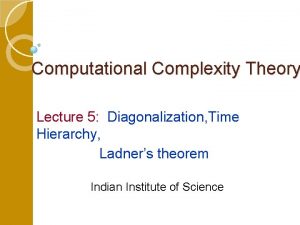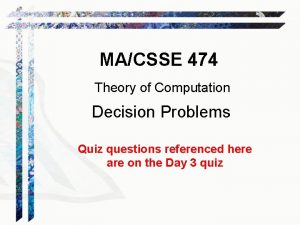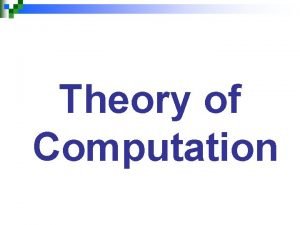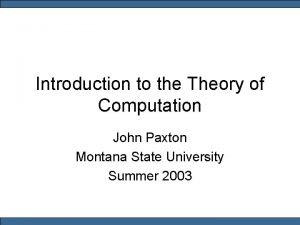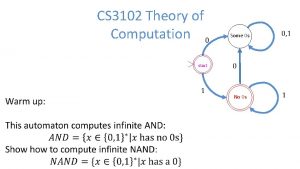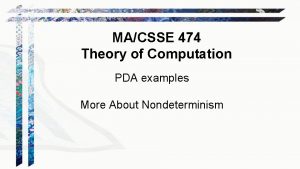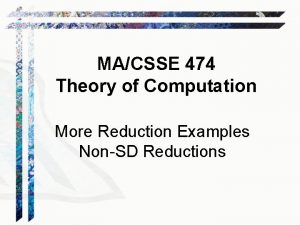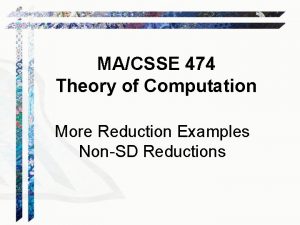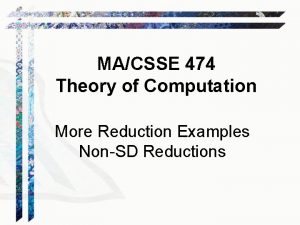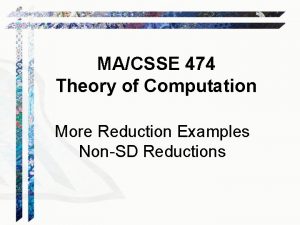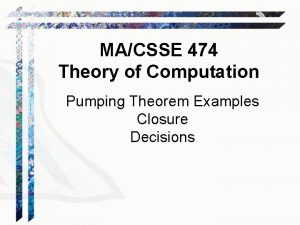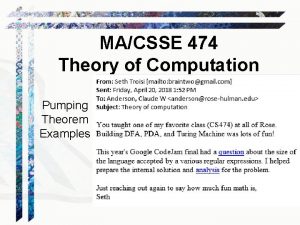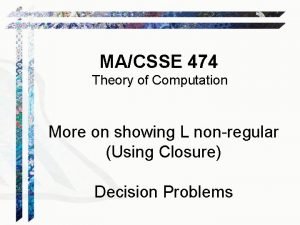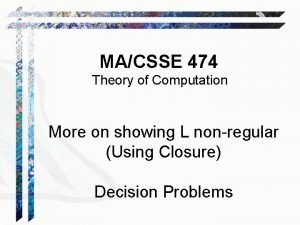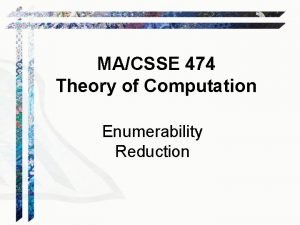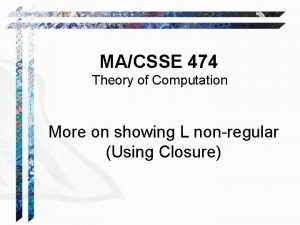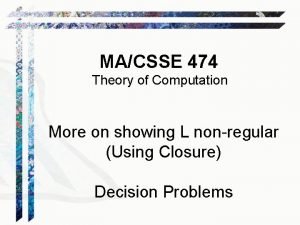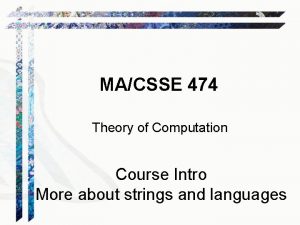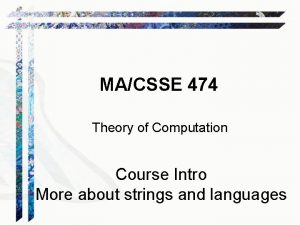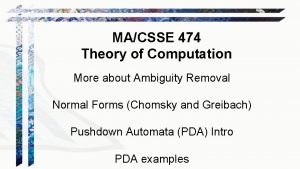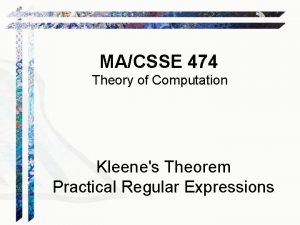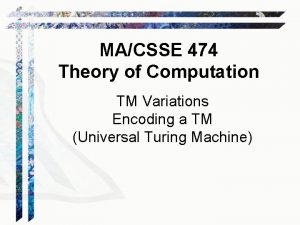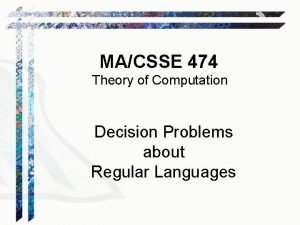MACSSE 474 Theory of Computation PDA examples More



























- Slides: 27

MA/CSSE 474 Theory of Computation PDA examples More About Nondeterminism

Your Questions? • Previous class days' material • Reading Assignments • HW 11 or 12 problems • Anything else

Recap: Definition of a Pushdown Automaton M = (K, , s, A), where: K is a finite set of states is the input alphabet and are not is the stack alphabet necessarily disjoint s K is the initial state A K is the set of accepting states, and is the transition relation. It is a finite subset of (K state ( { }) *) input symbol or string of symbols to pop from top (K state *) string of symbols to push on stack What does an individual element of look like?

Recap: Definition of a Pushdown Automaton A configuration of M is an element of K * *. The initial configuration of M is (s, w, ), where w is the input string.

Recap: Yields Let c be any element of { }, Let 1, 2 and be any elements of *, and Let w be any element of *. Then: (q 1, cw, 1 ) ⊦M (q 2, w, 2 ) iff ((q 1, c, 1), (q 2, 2)) . Let ⊦ M* be the reflexive, transitive closure of ⊦M. C 1 yields configuration C 2 iff C 1 ⊦M* C 2

Recap: Nondeterminism If M is in some configuration (q 1, s, ) it is possible that: ● contains exactly one transition that matches. ● contains more than one transition that matches. ● contains no transition that matches.

Recap: Computations A computation by M is a finite sequence of configurations C 0, C 1, …, Cn for some n 0 such that: ● C 0 is an initial configuration ● Cn is of the form (q, , ), for some state q KM and some string in * ● C 0 ⊦M C 1 ⊦M C 2 ⊦M … ⊦M Cn.

Recap: Accepting Computation A computation C of M is an accepting computation iff: ● C = (s, w, ) ⊦M* (q, , ), and ● q A. M accepts a string w iff at least one of its computations accepts. Other paths may: ● Read all the input and halt in a nonaccepting state ● Read all the input and halt in an accepting state with a non-empty stack ● Loop forever and never finish reading the input ● Reach a dead end where no more input can be read The language accepted by M, denoted L(M), is the set of all strings accepted by M.

Rejecting A computation C of M is a rejecting computation iff: = (s, w, ) ⊦M* (q, , ), ● C is not an accepting computation, and ● M has no moves that it can make from (q, , ). ●C M rejects a string w iff all of its computations reject. Note that it is possible that, on input w, M neither accepts nor rejects.

PDA examples Construct PDAs to recognize specific languages

A PDA for Bal M = (K, , s, A), where: K = {s} the states = {(, )} the input alphabet = {(} the stack alphabet A = {s} contains: ((s, (, ), (s, ( )) ** ((s, ), (s, )) **Important: This does not mean that the stack is empty

A PDA for An. Bn = {anbn: n 0}

A PDA for {wcw. R: w {a, b}*} M = (K, , s, A), where: K = {s, f} the states = {a, b, c} the input alphabet = {a, b} the stack alphabet A = {f} the accepting states contains: ((s, a, ), (s, a)) ((s, b, ), (s, b)) ((s, c, ), (f, )) ((f, a, a), (f, )) ((f, b, b), (f, )) How can we modify this PDA to accept {ww. R: w {a, b}*} ?

A PDA for {anb 2 n: n 0}

A PDA for Pal. Even ={ww. R: w {a, b}*} S S a. Sa S b. Sb A PDA: This one is nondeterministic

A PDA for {w {a, b}* : #a(w) = #b(w)}

More on Nondeterminism Accepting Mismatches L = {ambn : m n; m, n > 0} Start with the case where n = m: a/ / a b/a/ 1 2

More on Nondeterminism Accepting Mismatches L = {ambn : m n; m, n > 0} Start with the case where n = m: a/ / a b/a/ 1 2 ● If stack and input are empty, halt and reject. ● If input is empty but stack is not (m > n) (accept): ● If stack is empty but input is not (m < n) (accept):

More on Nondeterminism Accepting Mismatches L = {ambn : m n; m, n > 0} a/ / a b/a/ 2 1 ● If input is empty but stack is not (m > n) (accept): a/ / b/a/ a /a/ b/a/ 1 /a/ 2 3

More on Nondeterminism Accepting Mismatches L = {ambn : m n; m, n > 0} a/ / a b/a/ 2 1 ● If stack is empty but input is not (m < n) (accept): a/ / a b/a/ 1 b/ / b/a/ b/ / 2 4

L = {ambn : m n; m, n > 0} ● State 4: Clear the input ● State 3: Clear the stack ● A non-deterministic machine! What if we could detect end of input (as we can in real-world situations)? detect empty stack? ● Add end-of-input marker $ to Σ ● Add bottom-of-stack marker # to Γ

Reducing Nondeterminism ● Original non-deterministic model ● With the markers:

The Power of Nondeterminism Consider An. Bn. Cn = {anbncn: n 0}. PDA for it?

The Power of Nondeterminism Consider An. Bn. Cn = {anbncn: n 0}. PDA for it? Now consider L = An. Bn. Cn. L is the union of two languages: 1. {w {a, b, c}* : the letters are out of order}, and 2. {aibjck: i, j, k 0 and (i j or j k)} (in other words, unequal numbers of a’s, b’s, and c’s).

A PDA for L = An. Bn. Cn

L = {anbmcp: n, m, p 0 and n m or m p} S NC S QP N A N B A a A a. Ab B Bb B a. Bb C | c. C P B' P C' B' b. B'c C' c | C'c C' b. C'c Q | a. Q /* n m, then arbitrary c's /* arbitrary a's, then p m /* more a's than b's /* more b's than a's /* add any number of c's /* more b's than c's /* more c's than b's /* prefix with any number of a's

Closure question • Is the set of context-free languages closed under complement?
 More more more i want more more more more we praise you
More more more i want more more more more we praise you More more more i want more more more more we praise you
More more more i want more more more more we praise you Anbncn pda
Anbncn pda Macsse
Macsse Macsse
Macsse Macsse
Macsse Macsse
Macsse Ley federal del trbajo
Ley federal del trbajo Cecs 474
Cecs 474 Cecs 474
Cecs 474 Cse 474
Cse 474 Cecs 474
Cecs 474 Art 474 lft
Art 474 lft Turing machine is more powerful than:
Turing machine is more powerful than: Union set operation
Union set operation 2160704
2160704 Define transition graph
Define transition graph Theory of computation
Theory of computation Theory of computation
Theory of computation Ambiguity
Ambiguity Theory of computation
Theory of computation Cosc 3340
Cosc 3340 Time complexity hierarchy
Time complexity hierarchy Theory of computation quiz
Theory of computation quiz Computation
Computation Dfa to nfa
Dfa to nfa The theory of computation
The theory of computation Cs 3102
Cs 3102


